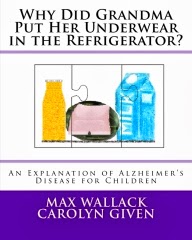Helping Children Stay Connected with Their Loved Ones Who Have Dementia
How do children internalize the dementia of a beloved family member and what can we do to help them connect and understand the process?

I was so impressed by the book that I asked Max to share more of his insights.
Here is a Q & A featuring some pieces of “Wallack wisdom.”
A. You want to allay the child’s fears so they can continue to have a loving relationship with their relative or friend.
A. I had a hard time understanding why Great Grams might be confused and behave very badly at home and then appear normal when we went out. A doctor told me that sometimes the nerve impulse in the brain jumps the synapse and sometimes it doesn’t. I tried to visualize this in the book with my illustration of the ball player who sometimes makes the catch and sometimes doesn’t. The diseased brain cell cannot always “make the catch.”
A. Her whole life, my great grandmother loved being with children. Being with me gave her great pleasure, even up to the last few days of her life.
A. Just being there can make a difference. Sometimes adult caregivers need a few minutes for themselves. Perhaps they need to cook a meal or take a shower. Even a young child could alert a caregiver if the person who has Alzheimer’s wanders outside or gets into some obvious trouble.
A. I developed a very early sense of responsibility and empathy. I know of other young caregivers who have a sense of caring and responsibility beyond their years. Their parents don’t thrust this responsibility upon them; rather, it is developed as they learn empathy. Children have a natural tendency to want to help. Parents should allow them to participate in the caregiving and not shield them from what is happening.
A. Very young children are often confused about the disease and worry it might be contagious. They need a simple explanation of what is happening. I believe Alzheimer’s disease should be taught in our schools. This could lead to mini support groups for children, perhaps facilitated by a guidance counselor. I hope schools might use “Why Did Grandma Put Her Underwear in the Refrigerator.”
A. People with Alzheimer’s disease are still the same people you have always known. They are “more there” than meets the eye. The trick is to find a means of communicating with them. The creative arts represent a great means of connection, since the area of the brain involved in creativity is one of the last areas affected by the disease.
 Max Wallack’s journey with his grandmother helped him identify his calling. He is a student at Boston University and a Research Intern in the Molecular Psychiatry and Aging Laboratory in the Department of Pharmacology and Experimental Therapeutics at Boston University School of Medicine. He is also the founder of PUZZLES TO REMEMBER. a project that provides puzzles to nursing homes and veterans’ institutions that care for Alzheimer’s and dementia patients.
Max Wallack’s journey with his grandmother helped him identify his calling. He is a student at Boston University and a Research Intern in the Molecular Psychiatry and Aging Laboratory in the Department of Pharmacology and Experimental Therapeutics at Boston University School of Medicine. He is also the founder of PUZZLES TO REMEMBER. a project that provides puzzles to nursing homes and veterans’ institutions that care for Alzheimer’s and dementia patients.
